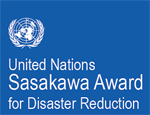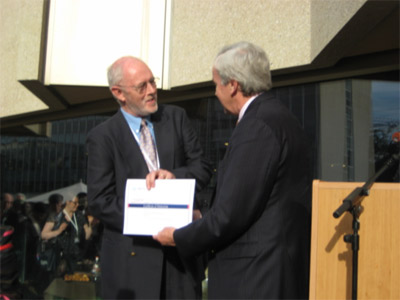About DWF
Sasakawa Award 2009

The United Nations Sasakawa Award for Disaster Reduction recognises excellence in reducing disaster risk for a safer more sustainable world.

John Norton receives the Sasakawa Award 2009 Certificate of Distinction on behalf of DW in Geneva on 16th June 2009 during the Second Session of the Global Platform for Disaster Risk Reduction.
35 years of community based Disaster Reduction and capacity building
The example of DWF work in Vietnam builds on 35 years of work in Africa, Central and South East Asia. In the 1970’s DW was training builders in Iran to integrate earthquake resistant principles in domestic construction; in 1983-85 DW was working with village builders to develop earthquake resistant construction using local materials in Guinea Conakry, and in the 1990’s DW was working in Pakistan and Afghanistan to integrate earthquake resistant construction techniques into building.
In Vietnam DW has worked on cyclone resistant construction since 1989 (see Norton, J, et al, “Typhoon resistant building in Vietnam”, Mimar 37, December 1990), and the work presented in the submission below builds on that experience. The DWF strategy in Vietnam since 1999 has in turn been used by DWF to develop the Safe House programme in Aceh, Indonesia with the British Red Cross, - addressing long term community based safe construction needs once the NGO have gone. Since 2008 DWF has gone on to develop the Safer Schools programme in Myanmar in partnership with the Save the Children Alliance using schools as a way to reach out to the population for safe home construction and retrofitting. Addressing a different, but no less devastating, kind of disaster DWF has worked on the issues arising from desertification and climate change in the Sahel since 1980, training many hundreds of builders to build without using either wood or imported materials.
DWF changes attitudes in Vietnam
When in 1999/2000 DWF started to introduce cyclone resistant construction with and through the population of poor communities in Central Vietnam this initiative was met at first with major scepticism on the part of Commune leaders and higher level authorities. They could not believe that it was either technically or economically feasible to strengthen the existing homes of the poor.
That position has been radically changed. By late 2006, following cyclone Xangsane, Thua Thien Hue Province (Viet Nam) authorities issued an official recommendation stipulating that all new buildings should respect DWF’s 10 key points of disaster resistant construction (See Doc N° 9).
This turnaround of official opinion represents a major achievement reflecting not only the robustness of the initial thesis (that poor communities can and will contribute from their own means to strengthening their homes) but also the success of DWF’s strategy to continuously engage with the authorities at all levels, whilst at the same time ensuring that local democratic and inclusive decision-making is strengthened.
By 2009 nearly 1 400 houses had been strengthened (929 reinforced, 450 rebuilt), 64 small public infrastructures built with direct support, and many other families, communes and local authorities assisted with technical and social guidance.
This achievement is both locally and internationally recognized. In 2008, DWF and its local team leader received a special certificate / medal from the Province in recognition of the special and important contribution of DWF to reduce the impact of natural disasters amongst the poor families in the Province. In 2008 the achievement of the DWF progamme in Central Vietnam was also recognized when DWF received a World Habitat Award.
Sasakawa Award submission for "Sustainable implementation of disaster risk reduction at community level".
A range of integrated actions in the DWF project have made important changes to the way the TTH community addresses DRR and these have an extremely positive and ongoing impact in the target community in how the address DRR and safer shelter and communities with major reduction in losses and damage:
- Establishing the principle and practice of preventive strengthening of houses;
- Developing hands on skills for DRR in building:
- Making prevention a priority through thoroughly participative animation and awareness raising:
- Making targeted credit for house strengthening available:
- Implementing that disaster risk reduction begins at school:
- Developed the DRR and safe house institutional environment amongst the communes:
- Making DRR at community level a core value: preparing commune damage prevention action plans:
Establishing the principle and practice of preventive strengthening of houses: Since 2000 DWF has promoted the preventive application of the ten key points (see Annexe 1) of flood and storm resistant construction in existing and new housing and public buildings in central Vietnam in collaboration with vulnerable families and communities. In addition DWF has actively supported the application of the same ten key points to the Government’s “Temporary House Replacement” (THR) (for poverty reduction) project – where hitherto in too many cases new houses built in the THR programme had been easily damaged by even small storms because safe construction features had not been respected and applied. DWF was asked to address this. Nearly 1400 houses have been made safe. Families show their appreciation by making a substantial contribution to undertaking the strengthening work, amounting to date $500 000.
Xangsane typhoon in 2006 demonstrated the efficiency of the DWF prevention approach. People know that preventive strengthening is cost effective. It costs 15 to 20% of a house value to make it safe, far less than the costs of reconstruction that many families have had to do on repeated occasions. Protecting the house against damage reduces the vulnerability of family finances to loss. Families apply the principles using their own resources
- Developing hands on skills for DRR in building: Prior to the DWF project, almost no builders have had any formal training in construction techniques and absolutely none in disaster resistant construction techniques. The DWF action provides hands on and theory safe construction/DRR training to local builders and building brigades in two day workshops in all the communes where it works, to improve the general quality of building and in order to develop skills in disaster resistant construction. Trained builders then work on local construction projects that bring in revenue, and work as building DRR advisers to families in the community. The presence of trained builders in the community sharply increases safety in buildings. Trained builders spontaneously apply the DWF principles of typhoon resistant construction. DWF also trains local architects and engineers in the province.
- Making prevention a priority through thoroughly participative animation and awareness raising: One message – “prevent typhoon damage”, numerous ways of communicating it: DWF makes information exchange and animation about the need for prevention against disaster a major priority. It uses all sorts of popular media - theatre, concerts, inter commune boat races, public announcements, street publicity, mobile displays and school events including school DRR theatre, shows, songs, painting, schools camps and parades. The project continues to develop a range of participative media using any idea that will lodge the ‘prevention idea’ in long term memories! Remember travelling puppet shows as child, always ending with a moral caution? These and other ideas deliver the DRR message. They are popular, remembered and have changed awareness and thinking about DRR for shelter. Vaccinate your house against the storm!
- Making targeted credit for house strengthening available: Between 2001 & 2004 DWF ran a pilot scheme providing families with affordable credit for house strengthening, repaid over 18 months. Families have been keen to take this opportunity and are good at repayments. In 2008 DWF has established a larger scale house strengthening credit programme in partnership with the Vietnamese Bank for Social Policy. Families recognize the social and economic value of a resistant safe home and the contribution it makes to family stability and growth and are ready to borrow to achieve this. A sustainable financial support system is fundamentally important and putting this in place has been a priority for DWF to help poor families reduce the vulnerability of their homes. Affordable credit helps people not have to borrow at high rates from usurious money lenders for building repair.
- Implementing that disaster risk reduction begins at school: DWF has an ongoing partnership with communes in Thua Thien Hué to strengthen existing public infrastructure and build safe new schools, markets, health facilities. At village level, DWF has worked with communes to build safe kindergartens and to strengthen and build primary schools so that children learn about safety and safe construction techniques in an exemplary safe environment and take these principles back to their families. DWF trains teachers about disaster prevention, and runs workshops with children about disaster prevention and about the child's role and needs before, during and after disasters. Children are active in school and in the community in promoting the vulnerability reduction message. For example, children put on plays that tell stories about taking preventive action, based on traditional mythology (Ocean Genii against Mountain Genii) and on humorous sketches such as a play about “The Stubborn Mason” who is too lazy and drunken to go for training in safe construction..
- Developed the DRR and safe house institutional environment amongst the communes: DWF has established Commune Damage Prevention Committees in each partner commune in Thua Thien Hue province, which act as the implementation partner at commune level – helping them to become strong and experienced Storm & Flood Prevention Committees. DWF has also supported the development of a communes Disaster Prevention Network that encourages those communes with experience of working with the DWF programme to help other communes develop their own action plans and DRR strategy.
- Making DRR at community level a core value: preparing commune damage prevention action plans: DWF has worked with families and with the people’s committees to develop short and long term (5-10 years) action plans for preventive action. DWF works to strengthen the institutional capacity to develop action plans for vulnerability and poverty reduction and to be able to assist families. DWF promotes democracy in the village decision making process to ensure equitable selection of partner families and a balanced gender approach. Recognizing that Vietnam is highly vulnerable to both disasters and climate change, DWF has worked to introduce both consideration about risk and the preparation of action plans at community level for better adaptation and mitigation (livelihood adaptation, land planning & infrastructures, public awareness and training).